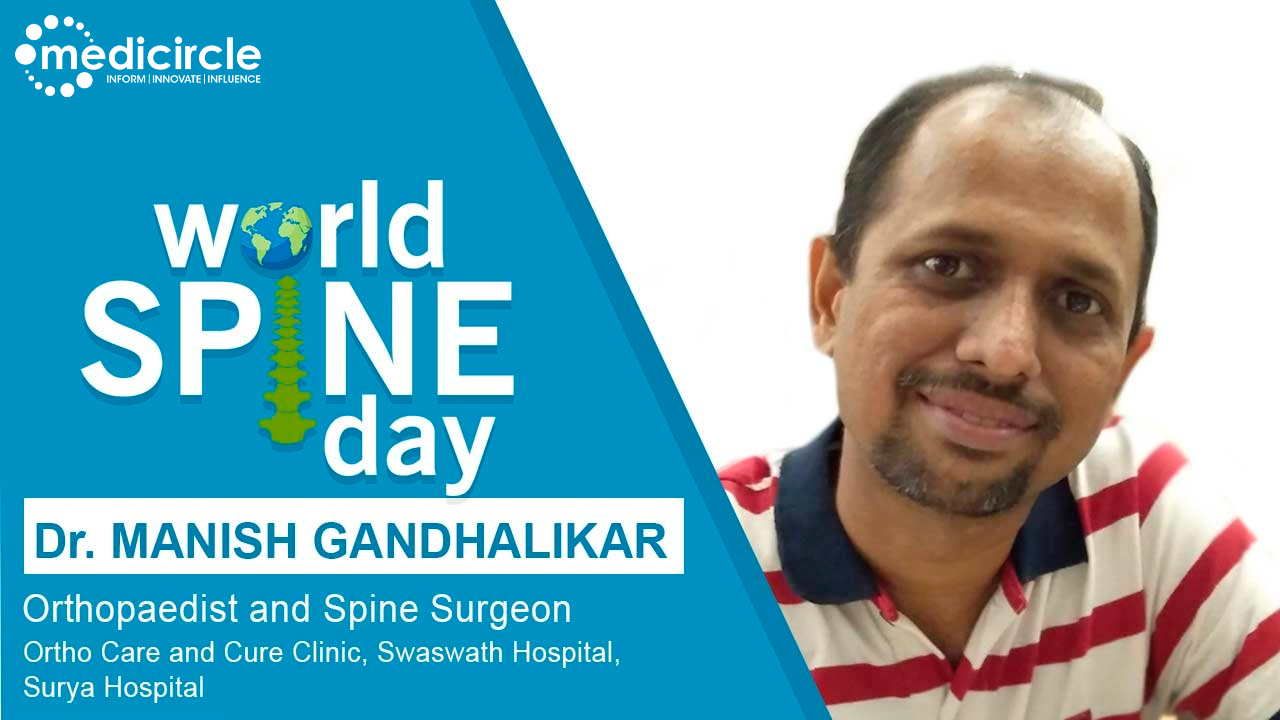The spine is our body’s central support system. It connects different parts of your musculoskeletal system. Your spine helps you sit, stand, walk, twist and bend. Back pain and other spinal pains are now common in both old and young people. Back pain is a serious issue as it can make any person bed-ridden for days and even for years. Around 20% who suffer from back and neck pain are in the age group of 16-34. On average 45% of people in India neglect their spinal treatment for more than 7 weeks.
World Spine Day is celebrated on October 16 to inform people about the struggles faced by spinal pain and its disability. The day seeks to promote the overall health and wellbeing of one’s spine. The day is organized by the World Federation of Chiropractic. A good posture and staying active are important to ensure good spinal health. We at Medicircle are conducting the World Spine day Awareness Series wherein we will be featuring experts in this field to understand and create awareness about good spine health.
Dr. Manish Gandhalikar is an Orthopedist and Spine Surgeon in Pune and has experience of 11 years of in these fields. He is associated with Ortho Care and Cure Clinic, Swaswath Hospital, Surya Hospital in Pune. He has done a fellowship in Spine surgery at ONP hospital, Pune in 2013. He is a member of the Maharashtra Orthopedic Association and Pune Orthopedic association. Some of the services provided by the doctor are Knee Braces For Osteoarthritis, Ligament Reconstruction, Knee Replacement, Shoulder Pain and Reconstruction and Rehabilitation, etc.
Reasons for Spine Pain
Dr. Gandhalikar begins, “Prolonged sitting and standing with the wrong posture are factors that contribute to spine pain. Lack of exercise and vitamin deficiencies are contributing factors. Improper posture is the most contributing factor when it comes to back pain in recent times.”
“After COVID, everyone has been stuck inside the home. The physical movements of playing and walking have completely stopped. At the same time, everyone has been glued to their screens. This causes them to strain their neck as they continuously glance down.”
“The adults are engaged in WFH. Previously in their office, they had the habit of moving around. Now it has turned sedentary with people working from their sofas and beds. In their offices, people used to have a proper setup which is missing in their home. In their home, people are prone to prolonged sitting without any form of physical movement or exercise. It is also contributing to their weight gain.”
“In the elderly, before COVID, they were able to walk in the sun and move around their neighborhood. Now their mobility has decreased. This gives rise to osteoporosis. It is a condition where bone density gets reduced making the bones more prone to fractures.”
"Being stuck inside one’s house means our exposure to sunlight has also reduced. This results in Vitamin D deficiencies, one of the causes of back pain. Pre-COVID only some had back pain due to prolonged sitting and due to a sedentary lifestyle. After COVID, back pain because of such bad habits has increased in the entire population.”
Is Spine Pain only for the Elderly?
He says, “Back pain can happen at any age. From children to elderly people, everyone can suffer from it. Every age has its own causes of back pain. In children, prolonged sitting and bad posture while looking at screens are the prime factors. Infections and TB could be some other contributing factors in kids.”
“In adults, prolonged sitting and jobs where they have to stand often are causes of back pain. Weight gain could also be a factor that causes back pain. In India, we mostly see central obesity. That is the fat gets stored around the stomach area. This causes strain on the spine, resulting in back pain.”
“In the elderly, the bones have gone through wear and tear, so back pain at that age was common. Due to osteoporosis, vertebral fractures are more common. In post-menopausal women, fractures due to osteoporosis are also common.”
Can Spine Pain be deadly?
Dr answers, “Spine pain cannot be deadly but it can be dangerous. Problems like simple back pain affect everyone at least once in their life. It is the result of muscle spasms and can get cured in 4 to 5 days. Another type is radicular back pain, wherein along with back pain you’ll experience pain in your arms and legs.”
“Early treatment in radicular back pain can help get desirable results. Delayed treatment can make the symptoms worse. It can cause the patient to feel tingling or numbness. Delayed treatment can also cause your arm and leg strength to reduce. Sensation in the bowel and bladder can get reduced.”
Tips for a Healthy Spine
He advises, “Avoid habits that cause back pain. Make sure you take a break of 5 minutes after every 30 minutes of sitting. If you could, do include stretching exercises in the middle. Similarly, prolonged standing should also be avoided by taking breaks in between. Maintain your weight as extra kilos can put a severe strain on your spine.
Exercise daily. Maintain your posture. Have a balanced diet. Expose yourself to sunlight for Vitamin D. Have mobility in your life.
Your spine is important. It connects everything from your head to toe. Maintain a good lifestyle for a healthier spine.”
,
(Edited by Priyal Shah)

 The pandemic has uprooted people's daily routines. This has increased the cases of back pain. Here are 5 tips shared by an Orthopedist that can help you reduce your back pain.
The pandemic has uprooted people's daily routines. This has increased the cases of back pain. Here are 5 tips shared by an Orthopedist that can help you reduce your back pain.









.jpeg)



.jpeg)
.jpeg)

.jpeg)


.jpeg)



.jpeg)
.jpeg)
.jpeg)


.jpg)

